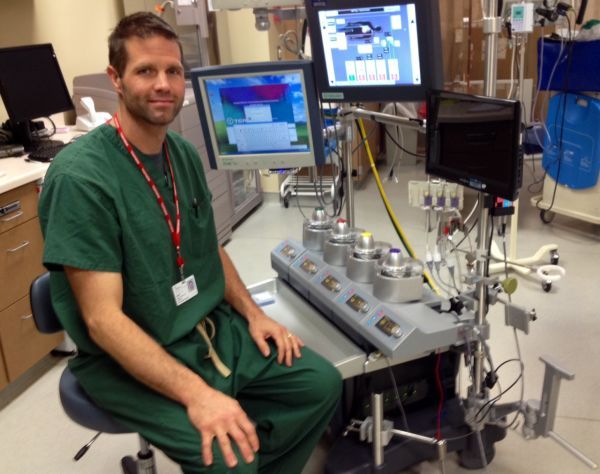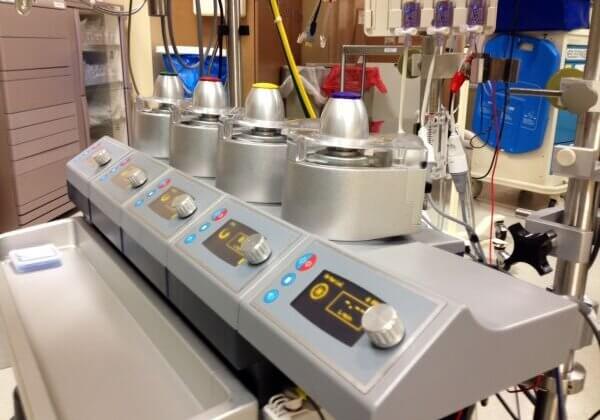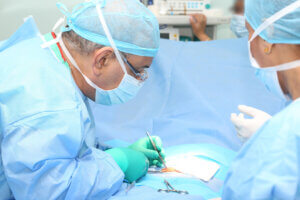Perfusionist controls heart, lungs' function during open heart surgery

Mercy Medical Center cardiac perfusionist Chad Brady sits by the hospital’s heart-lung machine that he operates. The machine, which is two years old and cost $80,000, maintains the circulation of blood and the oxygen content of the body during open heart surgery.
When a patient’s heart and lungs need to be stopped during coronary artery bypass or valve repair surgery, Chad Brady takes over the vital organs’ functions.
It’s a big responsibility for Brady who has been working at the hospital as a cardiac perfusionist for more than 17 years.
Brady stumbled upon the profession while pursuing a bachelor’s degree in exercise science. He went on to receive his masters degree from the University of Nebraska Medical Center, one of a limited number of perfusion schools in the country.
“It’s fascinating to me. I like taking care of these patients at this severity level,” he said. “You have to be on your toes at all times.”
Brady essentially has control of the patient’s body during surgery. Perfusionists maintain the circulation of blood and the oxygen content of the body during operations with a heart-lung machine — a system of pumps, filters, oxygenators and temperature regulators that oxygenates the body’s venous supply of blood and then pumps it back into the arterial system.
“When that patient’s on the heart-lung machine, (anesthesiologists) their role is significantly reduced because they don’t have control of the lungs or the blood pressure, so it’s kind of shifted to me at that time,” he said. “When we come off bypass then it’s all shifted upon them to care for the patient.”
When patients arrive at the emergency room with a ruptured aortic aneurism, Brady said he rushes into the operating room to get the heart-lung machine ready. He is one of two perfusionists on staff at Mercy. Kevin Christensen is the other.
The turnover rate of perfusionists at the hospital, Brady said is low. Since the perfusion program’s inception in 1978, there have been just six perfusionists.
During most open heart surgeries the heart is temporarily stopped. The organ’s temperature is decreased to near freezing and a high potassium solution is delivered to directly into the arteries through one of the heart-lung machine’s five pumps. The solution is similar to that used during execution by lethal injection. This process helps preserve the heart during surgery and allows the surgeon to work on it when it isn’t beating and full of blood.
“I’m draining the blood out of the patient and giving it oxygen and removing carbon dioxide, which the lungs do,” Brady said of his job. “I’m able to control pressures and temperatures by giving medications or whatever is needed. Then I return the blood back to the patient to continually support the patient while the doctor’s operating on the heart.”
“Some of our quicker cases might only be an hour. One last year was on bypass for eight hours,” he said. “It just varies.”
Once the surgeon is [done] operating, Brady delivers warm blood to the heart which helps it start beating on its own again.
By: DOLLY A. BUTZ [email protected]






I just graduated with my AS in Respiratory Therapy and Iam very very interested in a career in perfusion…. I am in California and disvovered there arent any schools out here for perfusion. I also hear that there arent many perfusionist will jt be difficult to get a job for me.
I do know that Arizona State has a very reputable perfusion school, which would probably be one of the closer schools to California. It may be worth it to explore schools in the mid-west as well. Please feel free to call us if you would like to shadow one of our perfusionists.
Aldonia, there are many perfusionists retiring, and a great need for new perfusionists. The last I heard from the largest Perfusion Service Company in the US, there were nearly 40 openings in that one company alone. Respiratory Therapists have a good background for Perfusion. Midwestern University in Glendale, Arizona, is a great school that’s within one day’s drive from much of California.